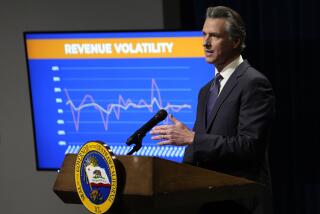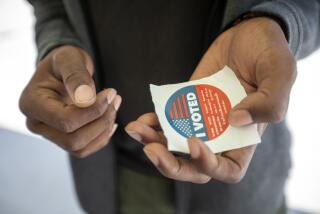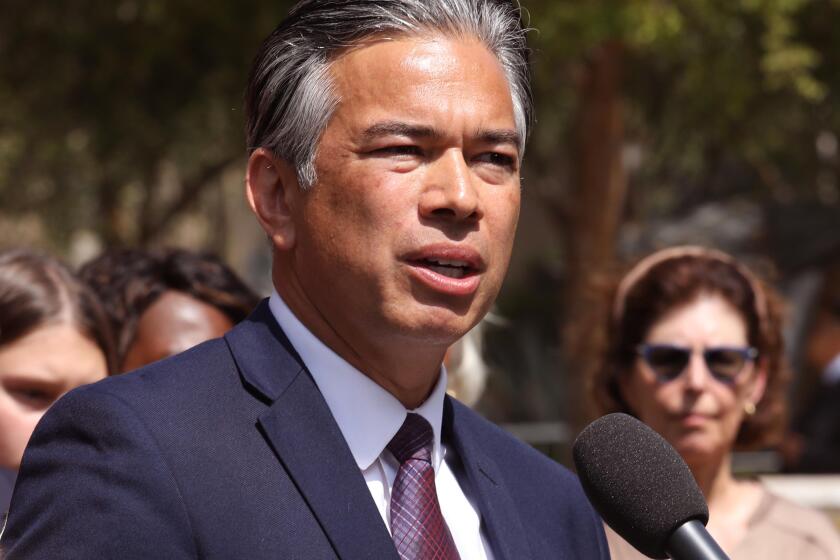Friday’s Deadline for Ballot Measures May Be Stretched
- Share via
SACRAMENTO — Lawmakers weighing Gov. Arnold Schwarzenegger’s financial recovery package know that Dec. 5 -- Friday -- looms as the official deadline to pass measures that must be put before voters on the March 2 ballot.
Secretary of State Kevin Shelley set that date, saying that he needed the time to print what already appears to be a complex ballot.
But the closer that deadline comes, the more elusive it gets.
With one day to go and lawmakers and Schwarzenegger far from agreement on what to ask of voters, some lawmakers have begun wondering if they can miss the Friday deadline and still place two budget measures on the March ballot.
Exactly how much leeway might exist is the subject of much Capitol speculation, with some longtime staffers suggesting that the Legislature can act weeks later if it is willing to waive various election laws and spend $3 million to $5 million printing and mailing a second ballot pamphlet to 12 million voter households.
The Friday deadline set by Shelley allows 88 days for bills to be signed by the governor and placed on the ballot. California officials have occasionally acted with more speed. For example, a piece of legislation made it onto the November 1998 general election ballot 68 days after it had been signed by the governor, and the June 1994 primary election included a ballot measure signed by the governor 84 days earlier.
Schwarzenegger wants the Legislature to ask voters in the March election to approve a bond issue of as much as $15 billion to balance this year’s budget and a constitutional amendment that would impose a permanent cap on how much the Legislature can spend. Many lawmakers, Democratic and Republican, have said they are uncomfortable with various aspects of the proposals.
Shelley continued to insist Wednesday that Friday is the true deadline to get the budget measures passed and enacted.
“He believes Dec. 5 is the optimal timeframe, in that it permits counties sufficient time to prepare and plan for a very important presidential primary,” said Shelley spokeswoman Terri Carbaugh.
Asked what Shelley would do if the Legislature and Schwarzenegger did not finish work on the ballot measures until Monday or later, Carbaugh said, “We’ll have to cross that bridge when we get to it.”
Some lawmakers said they were not assuming they could reach agreement after Friday.
“I talked to the secretary of state,” said Senate President Pro Tem John L. Burton (D-San Francisco), “and Friday’s the deadline.”
But longtime Capitol workers said the Legislature had occasionally blown deadlines set by the secretary of state.
“He will insist that it will be Friday, until Friday passes, then it won’t be Friday, it’ll be the next day,” said Senate Chief Executive Greg Schmidt. “He’s doing his due diligence in saying that’s the day I need to get all the printers lined up in time,” Schmidt said. “In real life, there’s some flexibility. It can slop over a little without having to go to an extra ballot.”
Carbaugh said the driving force behind the deadline is the printing of the ballot. Counties will print the ballot beginning Dec. 25, she said, and printers must have the election material by Dec. 15 to set up their equipment and make corrections on the ballots before printing begins.
Before the 15th, she said, either the Legislature or the attorney general must provide a title and fiscal analysis of the measure put before voters. Current law requires 20 days for the public to review the title and analyze and challenge it if they believe it is inaccurate or unfair.
In setting a Dec. 5 deadline, Carbaugh said, Shelley had already assumed that the Legislature would shave that public review period from 20 to eight days. The Legislature could compress it even more with a two-thirds vote.
There also will be a presidential primary election in March. Besides presidential nominees, the ballot pamphlet will include candidates running for a U.S. Senate seat, 53 congressional seats, 20 state Senate and 80 Assembly seats, plus two ballot measures.
*
Times staff writer Dan Morain contributed to this report.
More to Read
Get the L.A. Times Politics newsletter
Deeply reported insights into legislation, politics and policy from Sacramento, Washington and beyond. In your inbox twice per week.
You may occasionally receive promotional content from the Los Angeles Times.










